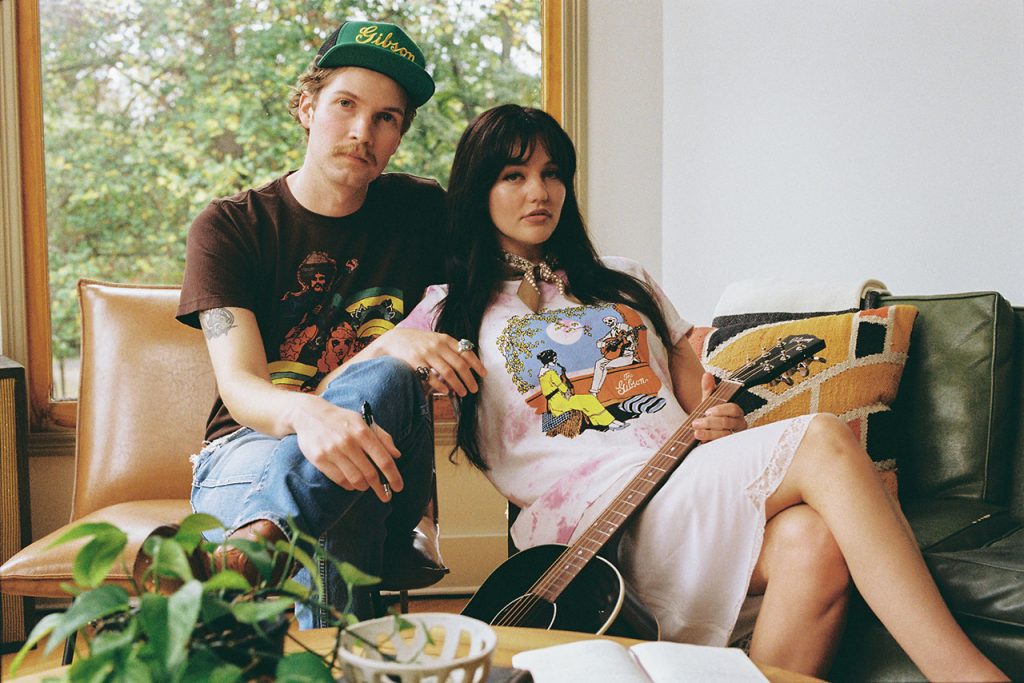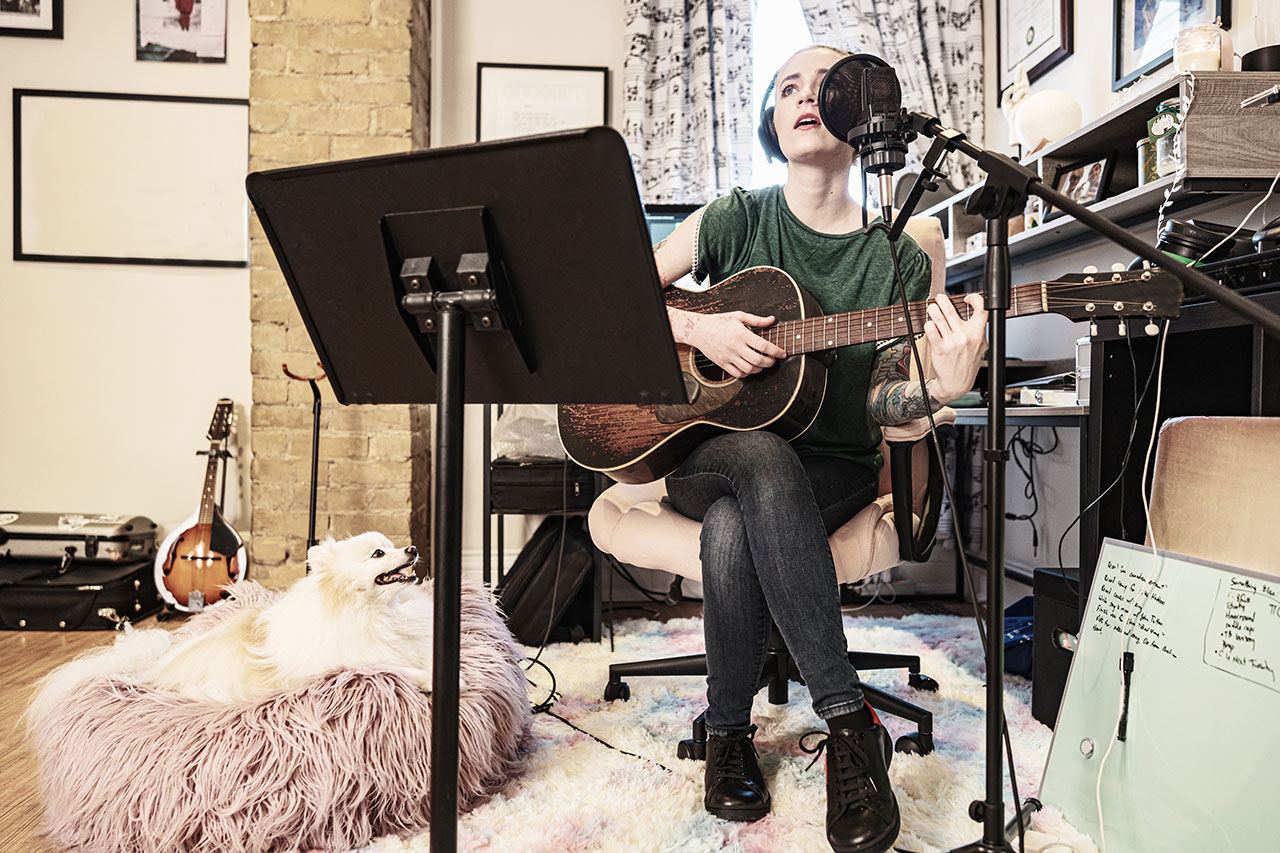Part two of an ongoing series designed to inspire you toward musical productivity
Be honest: sometimes, your usual patterns just don’t cut it anymore. Like a pond that’s grown stagnant, your creative mind can benefit from a fresh stream of ideas. Our experiences as guitar players and musicians in general vary wildly, but we all share a core similarity in that when we’re left to our own devices for too long, we can become complacent or repetitive. I notice it in myself constantly.
Seeking inspiration from outside your comfort zone is an effective way to reignite motivation. In this continued effort to spur you into greater productivity, here are some new strategies to shake things up. I wrote part one of this series in March of 2023, and the ideas there are still valid, so feel free to blend in some of those if you missed the first article.
Whether you just started playing guitar or have been playing for a long time, the Gibson App can help guide you toward good habits, a good ear, and learning songs. Start here to gain insights into what to do at the beginning of your journey as a musician.
1) Organize a monthly micro-showcase (in person or online)
Rather than waiting for a big gig to strut your stuff, plan a short, focused performance—15 or 20 minutes—once a month. You can do this at a local coffee shop or even via a livestream. The goal is to prepare a small but polished set of material—songs are where the financial rewards are.
This reduces the pressure of a full-blown concert while still motivating you to stay fresh. Over time, you’ll gather a repertoire you can expand for bigger opportunities and develop a routine of consistent prep and performance.
- Actionable task: Reach out to a local café or use a platform like Instagram Live or Twitch to schedule a monthly performance date. Write it on your calendar and commit. Having a looming micro-show will give your practicing or songwriting a tighter focus. However, if the stress of that is too much, consider recording the concert privately in your studio to prove to yourself you can actually do it. Then, do it a few more times, and you’ll have some cool mini-shows to publish on social media. That approach may also buy you some time to develop a logo, edit the content a bit, and generally make the presentation a lot slicker. First impressions matter!
- How the Gibson App can help: Use the app to learn popular covers for your show. You’ll find many bands and styles to choose from.
2) Start a personal practice curriculum
When deciding what to learn next, it’s easy to procrastinate—especially with all the tutorials and tips floating around online. Instead, craft a structured syllabus for yourself like a music teacher would for a student. Break down your goals by week or month: that might mean scales and modes for one segment, chord inversions for another, and rhythmic drills for yet another. The Gibson App has organized material that can inspire an approach for this, or you can integrate some aspect of the app into your personal track.
- Actionable task: Write out your “curriculum” for the next four weeks. Plan specific benchmarks and treat them as homework deadlines. Post them on your wall or keep them in a project management app to stay accountable.
- How the Gibson App can help: Seek out songs that enhance your benchmark goals. If you’re learning new chords and scales, the app has plenty to offer.
3) Compose a short jingle for a local business or cause
Instead of waiting for a big licensing opportunity, create one. Offer to write a short theme or jingle for a local bakery, a charity organization, or even a friend’s side hustle. This exercise forces you to think outside of your usual creative box; you’ll be matching a brand identity or a mission statement, which can be great for building compositional chops you might not explore in your personal projects.
- Actionable task: Identify one small business in your area without a signature sound or jingle. Approach them with a concise pitch. You’ll craft a brief, catchy tune for their online ads or store ambiance. Even if it doesn’t lead to a massive payday, the experience (and portfolio piece) is invaluable.
- How the Gibson App can help: Look closely at the songs in the app that are the most popular and compare their choruses. A chorus is not unlike a jingle in that it must convey condensed emotion in a short amount of time.
4) Revive older tools and gear you’ve neglected
Most of us have a piece of equipment or a software plugin that was exciting at first but got sidelined as new toys entered the picture. Challenge yourself to dust off that neglected guitar pedal, plugin, or synthesizer, and see what fresh ideas emerge. A forgotten tool can often trigger creativity simply because its sounds and workflow differ from your current go-to setup.
I recently did just the opposite in identifying stuff that really just needed to be sold and removed from my life, but we’re all at different stages of clutter in our studio. For me, there were too many objects to organize and dust. Too much stuff was holding me back.
- Actionable task: Choose one piece of gear or plugin you haven’t touched in months. Make it the star of a new project or jam session. Restrict yourself to primarily using that neglected tool, so you’re forced to dig deeper into its potential.
- How the Gibson App can help: With its tuner and metronome, you may find the app much more convenient than separate devices for these tasks.
5) Launch a 30-day ear-training challenge
Developing sharper ears can elevate every aspect of your musicianship. Maybe you’re good at picking out single-note guitar parts but struggle with chord progressions, or perhaps you can hear intervals but have trouble identifying rhythmic patterns. Dedicate a focused, daily session—just 10-15 minutes—to ear-training exercises. Within 30 days, you’ll notice a clearer connection between what you hear in your head and what you play on your instrument. Progress is inevitable if you stick with it.
- Actionable task: Download an ear-training app or find a reliable YouTube series that walks through intervals, chord recognition, and rhythmic dictation exercises. Commit to a short, daily practice session. Track all of this in a journal to stay motivated and for a weird type of private accountability since you can see how lazy you’ve been or not been.
- How the Gibson App can help: Within the app, you’ll find tons of opportunities to focus on sections of songs in more detail, complete with tablature.
6) Collaborate with an unlikely partner
Branch out from your typical jam buddy or bandmate. If you’re primarily a rock guitarist, team up with a classical pianist or a folk violinist. If you mostly produce hip-hop, consider working with an R&B singer, an ambient electronic artist, or any combination of the above. The friction between styles can spark unexpected moments of brilliance and help you grow by adapting to someone else’s perspective and methodology.
- Actionable task: Look for local musicians or post on a forum or social media group dedicated to a different style. Propose a single-track collaboration. Keep it straightforward—maybe co-write one song or do a one-off performance. The goal is to immerse yourself in a fresh approach, not commit to an entirely new band.
- How the Gibson App can help: In the Genres section of the app, investigate the lessons on styles you don’t normally listen to and see if you can get inspired by them. Use that motivation to contact another player in that style, as suggested above.
7) Build your brand and monetize your skills
Even if you’re not aiming to become a full-time professional, establishing a recognizable brand and some income from your music can be a huge confidence booster. Maybe it’s selling custom loops or sample packs, offering lessons, or creating video content. It’s about combining your identity as an artist with entrepreneurial thinking.
- Actionable task: Brainstorm three ways to earn money with your music outside of standard gigs. It might be session work, sync licensing for small indie films, or teaching workshops. Pick the most feasible idea and explore the first steps—like creating a simple website or Fiverr profile to advertise your service.
- How the Gibson App can help: Compare your skill level to the teachers within the Gibson App. Observe how they’ve applied what they know to courses and mini-lessons. If you feel like you’re on their level, use that as a confidence booster to take on a few students yourself, using the Gibson App as a teaching aid.

Image: Part of your brand is your image, and Gibson offers many options for apparel
8) Develop a routine of accountability and reflection
What many musicians lack isn’t talent or gear but a reliable system of accountability. Creating rituals of accountability can accelerate your growth by forcing you to take stock of what is and isn’t working. Nobody else can do your practice sessions or finish your arrangements, but a regular accountability rhythm can keep you on track.
- Accountability partner: Find a friend, fellow musician, or mentor and schedule a weekly check-in. Share your progress and trade demos, and give each other critiques. I’m part of a private Discord that does this very thing. It’s a microcosm of a larger forum, but it’s invitation only, which seems to have created a realm of respect you may not find on a public forum.
- Daily reflection: At the end of each day, jot down a “music minute”. How did you spend your practice time, what breakthroughs did you have, and what challenges remain? Writing it out crystallizes what happened so you can move forward deliberately.
- Periodic review: Once a month, look back over your notes. Identify recurring issues—lack of time, certain technical hurdles, marketing blind spots—and make a plan to tackle them systematically.
- How the Gibson App can help: As you discover your weaknesses, use the well-organized sections of the app to address those issues for improvement.
Wrapping it all up with a tidy bow
Keep your mind open to the reality that progress comes from a blend of curiosity, consistency, and adaptability. If one method isn’t yielding results, pivot to another. In the same way a single chord can lead to countless song possibilities, these creative prompts open countless roads to growth. Your music deserves to reach its fullest expression, and you deserve the fulfillment of continually improving your craft.
One must recognize the season. If you’re a beginner, it’s like spring—it’s time to plant good habits and imbibe foundational material. If you’re an experienced veteran, it’s time to harvest and tuck away some seeds from that harvest for next year. There’s wisdom in doing that. Don’t use up all your energy right now, so there’s some left for later on.
A new year is symbolically a great time to consider these things, and I do hope that you land on your feet in 2025 with a vision for what your life and musicality need to thrive.
Download the Gibson App and get started.

